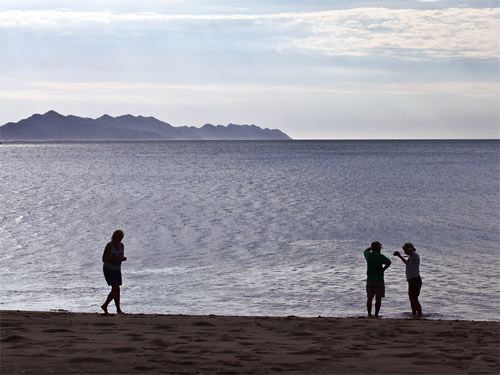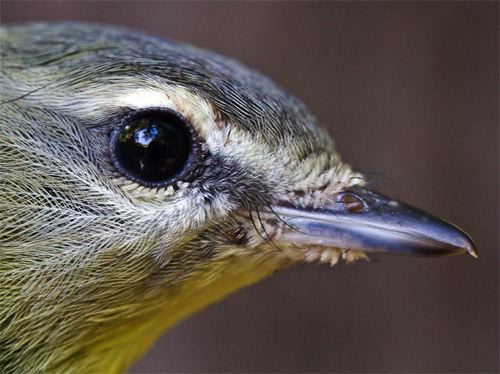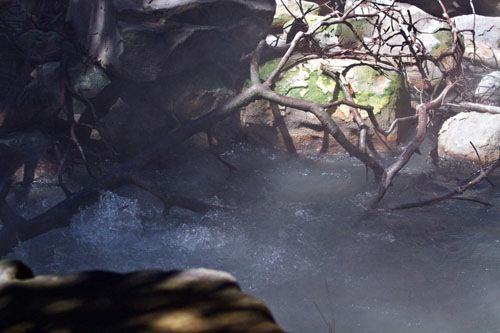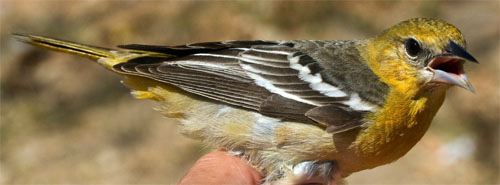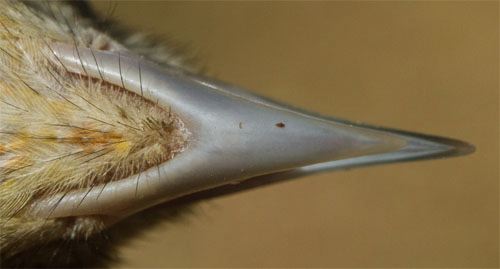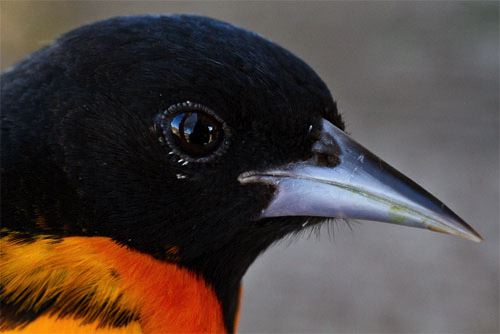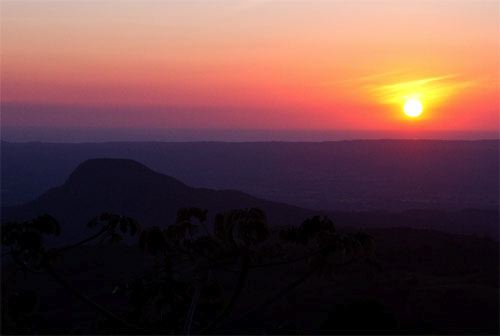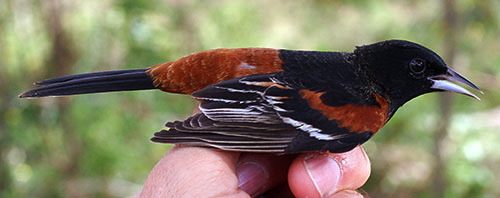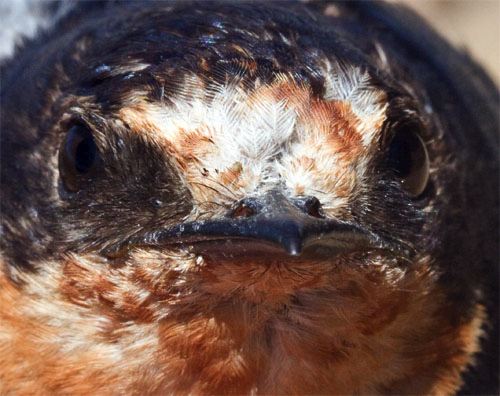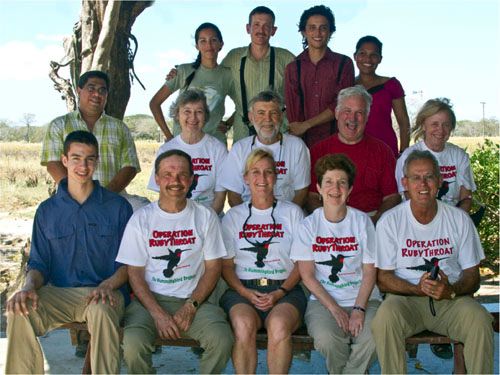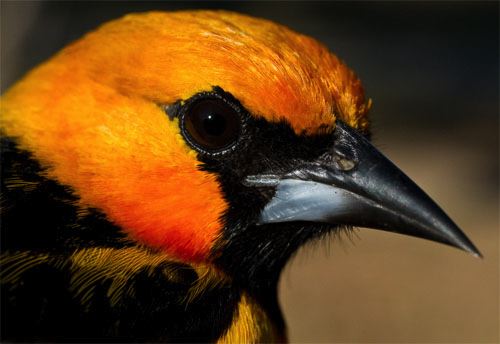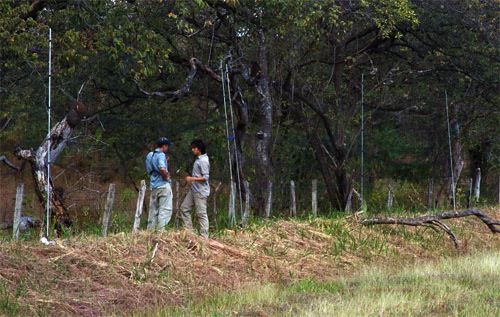|
|
|||
|
|
|
Join fellow birders & educators as citizen scientists on our final 2011 |
|
THINGS GO AWRY: With logistic support from Holbrook Travel, Hilton Pond Center this week mounted its 11th successful "citizen science" hummingbird expedition to Costa Rica, where we’re conducting the only long-term systematic banding study of Ruby-throated Hummingbirds on their non-breeding grounds in Central America. Each winter since 2004-05 Operation RubyThroat: The Hummingbird Project has taken at least one group of U.S. and Canadian citizen scientists to Guanacaste Province, where sizable numbers of ruby-throats occur in fields of Aloe Vera—the “burn plant” used in everything from medicinals to health foods to a yarn additive that soothes the fingers of folks who knit. Aloe’s a drought-tolerant non-native plant from Africa whose flowers produce a heavy nectar load apparently irresistible to many hummer species, so we annually gather in the aloe fields in January or February to capture, band, and observe migratory ruby-throats such as the heavily streaked immature male below.
All text, charts, maps & photos © Hilton Pond Center The mid-winter relationship between aloe and Ruby-throated Hummingbirds (RTHU) was discovered a little more than a decade ago by our highly competent tour guide and colleague Ernesto Carman Jr.; this was about ten years after aloe was introduced as a commercial crop in the arid, rich, volcanic soil of Guanacaste--a Pacific Coast province that was a much-less-toured region than San Jose or the cloud forests in Costa Rica’s eastern half. With daily flights into the provincial capital of Liberia, the region is under development and more and more people are visiting or settling in Guanacaste. Depending on your viewpoint, this can be a good or bad thing--especially along the province’s western shore where hotels are springing up like weeds and eliminating critical maritime habitat. As expected, this year we discovered new things about wintering ruby-throats in the Neotropics. We also experienced some unusual circumstances--one of which was a real shock and a setback for our long-term studies. This year's trip was still quite productive, however, so to learn all about our just-completed Costa Rica expedition, please read on . . . . PRE-GROUP SCOUTING As usual we headed out for Costa Rica several days ahead of this year’s group to meet up with Ernesto. Thanks to help from wife Susan we got to the Charlotte NC airport on 26 January for our 1 p.m. flight, which arrived on-time four hours later in San Jose. There we were greeted by Ernesto, who had just finished leading a 14-day non-research tour for U.S. birders and who whisked us away to his home base at Paraiso--
All text, charts, maps & photos © Hilton Pond Center On 27 January we got to see Ernie Carman’s latest improvements and additions to his on-site coffee mill and spent several hours watching and photographing birds (and mammals) visiting a backyard feeder stocked with bananas--a food quite different from thistle and sunflower seeds we’ve been offering all winter for finches at Hilton Pond Center. In Ernesto’s eyes the banana feeder’s most unusual visitor was a Gray Catbird--a North American migrant quite uncommon in eastern Costa Rica. Personally, we were impressed by the colors and antics of a Variegated Squirrel, Sciurus variegatoides (above), a tropical relative of the Bushy-tailed Tree Rat (AKA Eastern Gray Squirrel) that raids our feeders back home.
All text, charts, maps & photos © Hilton Pond Center Several eye-pleasing tropical birds also partook of the ripe yellow fruit, including Blue-gray Tanager, Clay-colored Thrushes (Costa Rica’s national bird), White-eared Sparrows, Great Kiskadees, Blue-crowned Motmots, Passerini’s and Silver-throated Tanagers, and--oddly enough--Hoffman’s Woodpecker, a congener of our Red-bellied Woodpecker.
All text, charts, maps & photos © Hilton Pond Center Our favorite banana-eaters, however, was a matched pair of 14-inch-tall Emerald Toucanets (above), whose massive, yellow upper mandibles perfectly matched the fruit they were eating. Some taxonomist believe this cavity-nesting bird--which occurs from southern Mexico to central Bolivia--should be split into as many as seven species.
All text, charts, maps & photos © Hilton Pond Center While we photographed these colorful birds, Ernesto and Ela went about collecting the banding gear he’s kind enough to store between our Costa Rica hummingbird expeditions. He and his father designed a rooftop carrier (above) to mount on Ernesto’s car for our 24 10-foot-long mist net poles, Upon arriving in Liberia we checked in at our hotel and picked up Juan Diego Vargas (at right in photo)--a Costa Rican tourism management student and birder we met last year who has been maintaining sugar water feeders and making RTHU observations for us. From Liberia we drove north on the Pan American for about ten miles to Cañas Dulces, the little town where Ernesto had discovered RTHU in an extensive Aloe Vera plantation. The fields, owned by Guatemalan farmer Alfredo Oliva Veliz, had been home to Operation RubyThroat’s hummingbird research during the previous ten expeditions, so we were eager to find out whether the aloe was once again making the bright yellow flowers laden with nectar that proved to be irresistible to ruby-throats. JuanD had helped us in 2010, but we were excited to be showing the research site to Mirna for the first time.
All text, charts, maps & photos © Hilton Pond Center When the Omega Crew arrived at the aloe fields--whose entrance is at the end of a bumpy, dusty, winding dirt road that crosses a stagnant stream--we became quite suspicious at what we saw. Instead of a barbed wire gate at the edge of Fields 2 & 3 (where we had mist netted RTHU in 2006 and 2007), we saw a wide driveway leading to a new house and several large outbuildings in which construction vehicles were parked. Moreover, Field 2 was covered with a lush new growth of grass--not the long, straight rows of aloe we were used to. Compare the 2011 view of Field 2 (above) to a photo we took in 2006 (below). Obviously, something had gone awry.
All text, charts, maps & photos © Hilton Pond Center We drove past the new house to a second barbed wire gate and headed on down an even bumpier road that led to the rest of the aloe fields. As we drove past Fields 2 & 3 we noted once again that where aloe plants had once flourished there was now only grass. Driving further we found this to be true of Fields 4 & 5, which had produced several hundred RTHU in 2008 and 2009; alas, as we proceeded we found acre after acre of grass and not even one aloe plant in sight! Click on the image above to open a larger photo in a new browser window Needless to say, we were astounded at this turn of events and drove even further into the aloe farm (above), hoping against hope that Fields 6 & 7 would look more promising, but such was not the case. Finally we got to Field 8 where several cars and pickup trucks were parked and where we could see men working. Ernesto, who serves as our Spanish-English translator asked one of the men if Franklin was around--Franklin being the aloe farm’s resident manager whom we had befriended. The first man gestured to another guy who had his back to us, so Ernesto walked up and called out a greeting and the name “Franklin” en español. The second man turned around and said, “No, I’m not Franklin, I’m Frank, and please speak English.” It turns out Frank, a Boston native who made his fortune leasing heavy construction equipment in Costa Rica and elsewhere, a few months earlier had bought the Cañas Dulces aloe farm lock, stock, and barrel and was in the final stages of turning the entire 600-acre property into a cattle ranch. Frank had mowed down or scratch-plowed most of the hundreds of thousands of Aloe Vera plants and sold a small portion to another aloe farmer for transplanting. He had left only a small aloe patch about 20’ x 50’ in Field #10--a prolific spot in which we had banded RTHU for the first time in 2010 and now a feeble remnant of what was once a spectacular midwinter magnet for hummingbirds, orioles, warblers, buntings, and many other Neotropical migrants. Frank was friendly and encouraged us to continue research on the cattle farm, but that would have been a fruitless endeavor with no floral source to concentrate hummers for banding and observation. Ouch!
All text, charts, maps & photos © Hilton Pond Center Bidding Frank adieu, we drove back out the bumpy, dusty, winding dirt road, numb with the realization we had lost an entire study site to a change in agricultural use. When we climbed up a low knob that overlooked Fields 4 & 5, the resulting vista drove home that what once was expansive fields of yellow aloe blossoms was now nothing but grass that soon would be home to herds of Zebu cattle raised for beef export. (Compare the 2011 view above with a 2009 photo below from the same vantage point.)
All text, charts, maps & photos © Hilton Pond Center Although the aloe plantation had allowed us to be the first to demonstrate how some RTHU returned to the very same wintering sites a year after being banded in Costa Rica, our studies of Neotropical site fidelity had abruptly come to a halt. Likewise, we wouldn’t be learning anything new at Cañas Dulces about winter territoriality or hummingbird longevity--not very good news for an on-going long-term project entering its eighth year. (To make matters even worse we somehow lost our brand-new stainless steel water bottle in the fields back at Cañas Dulces. Ouch! We hope Frank’s workers can make use of it.) Even though the situation might have seemed hopeless, we had a possible alternative up our sleeve.
All text, charts, maps & photos © Hilton Pond Center Back in 2009 we had found an aloe processing plant just south of Liberia--a facility called Finca Sabila that was owned by Texas-based Carrington Laboratories. The site included a number of Aloe Vera fields (above) that were fenced-in and guarded. We tried unsuccessfully to gain access but did run mist nets on an abandoned road outside Carrington’s northern edge.
All text, charts, maps & photos © Hilton Pond Center Our banding work at the Carrington perimeter (above) was relatively productive in 2009, especially since the aloe at Cañas Dulces wasn’t blooming all that well those years and was hosting fewer hummingbirds. Early last year, however, Carrington went bankrupt, we were unable to contact anyone for permission to enter, and--worse yet--the bank that was holding the note for the site told temporary workers to cut the flower stalks off the aloe in the hope of increasing yield for a possible bankruptcy sale. Removing nectar-bearing blossoms did nothing to help our hummingbird studies in 2010, so this year when we left the nouveau cattle ranch to drive back south past Liberia to Finca Sabila we didn’t know what to expect. We arrived at the locked gate to Finca Sabila on 28 January 2011 and found the guard shack empty; there was, however, a phone number we called to leave a message of inquiry. With no one around we drove back toward the perimeter fence line and noted several new houses under construction along the way. We were concerned vegetation had been cut on the path that had served a net lanes the past two years and that a second barbed wire fence had been removed--signs the property adjoining Finca Sabila probably was slated for some other purpose. Fortunately, the fields within the finca were in pretty good shape and--lo and behold--there were quite a few ruby-throats feeding on yellow aloe flowers. Despite the loss of the Cañas Dulces study site, it looked like we at least had a place to catch hummers again in 2011, so with this news we headed back to the hotel and prepared for the next day’s arrival of our new group of citizen scientists from North America.
All text, charts, maps & photos © Hilton Pond Center DAY ONE By late morning we (Ernesto, Bill, and bus driver Randall) were at the Liberia airport about ten miles west of town, awaiting the arrival of our first travelers. They were coming from all over the U.S. as far away as Seattle, so some were putting in a very long day of flying. First to get her bags and clear customs was Lisa Billow (Norfolk VA), who actually had been in Costa Rica for a few days on a pre-expedition extension. She was followed soon thereafter by Alice Bard & Jack Stout (Winter Springs FL), Judy Bridell (Minneapolis MN), Nick Whittredge (Northampton MA), and Tom Schilke (Waterloo IA, above).
All text, charts, maps & photos © Hilton Pond Center These were the first six of our eight-person 2011 group, with long-distance fliers Heidi Ondrasik (Woodinville WA) and Ed Sypek (Neenah WI) scheduled to de-plane later in the evening. As each person arrived, Ernesto guided them to the bus where Randall stowed their gear before our short trip to a very nice open-air traditional restaurant (above). There we all chowed down on a late lunch that forecast the tasty, filling fare that is always a hallmark of our Neotropical trips. From the restaurant it was off to El Sitio Hotel, a Best Western just a block from the main Liberia intersection on the Pan American Highway. This was the first time we’d arranged for the group to stay at El Sitio Hotel, and it turned out to be a fortuitous choice. On the previous ten expeditions we took food and lodging at Buena Vista Lodge, a former cattle ranch an hour above Cañas Dulces. Situated about 2,400’ halfway up the Rincon de la Vieja volcano, Buena Vista provided spectacular views all the way to the Pacific Ocean and did provide access to the original aloe fields, but now that they had been replaced by Frank’s cattle farm it made much more sense to be at El Sitio--about ten minutes max from the Carrington study site. (This relocation to El Sitio was a stroke of genius, or maybe dumb luck. We had made the change because we had grown weary of the one-hour commutes along the dusty, bumpy, winding road to and from Buena Vista each morning and afternoon, and especially because Buena Vista ran out of hot water so often we NEVER seemed to get a hot shower after a hot day in the field.)
All text, charts, maps & photos © Hilton Pond Center We had some initial concerns about staying at the relatively luxurious El Sitio Hotel--a modern, corporate-style facility so close to Liberia--but most of those melted away quickly. Although we never watched TV, we did enjoy air conditioning and delicious meals at El Sitio’s in-house restaurant, made use of laundry and Wi-Fi services, swam in the pool, watched birds in an adjoining wetland, AND--of supreme importance--took hot showers whenever we wanted! El Sitio also had a conference room where we could gather in comfort each evening to discuss the day’s accomplishments, learn fascinating tidbits about group participants, and hear the latest scientific information about hummingbird ecology and behavior. The way things were going, you might know that for the first night’s lecture--a summary of Operation RubyThroat’s considerable successes in Central America--our compact digital projector failed to work, likely thanks to rough-and-tumble baggage handlers. (Bottom line: All week the group watched our Keynote presentations on the screen of our 17” MacBook Pro, and to get a new projector in time for our next expedition we had to order one through Amazon.com to the tune of $979--not exactly an expense we had budgeted. Ouch!) By 10 p.m. all eight of our 2011 participants in the 11th Operation RubyThroat expedition to Costa Rica had arrived and headed off for bed after a long day of travel. As is our custom, we gave the group a unique nickname to distinguish them from the 125-plus citizen scientists who had preceded them. With appropriate dignity, pomp, and circumstance, we dubbed them “Th’Levens.”
DAY TWO During the first night’s lecture we had described for Th’Levens the sad story of those now-defunct aloe fields at Cañas Dulces and explained what to expect at the Carrington facility. The next morning we ate an early breakfast, boarded our sleek and shiny air conditioned tour bus at El Sitio Hotel, and headed off for Carrington--an easy ten-minute ride on level asphalt that was quite different from that one-hour trip down a dusty, bumpy, winding mountain road from Buena Vista. (We were always ready to ask driver Randall to stop the bus, above, if we saw something interesting.) After arriving at our study site we broke out all the gear and demonstrated how to string 39-foot-long mist nets on 10-foot-tall metal poles, how to drive reinforcing bars (rebars) into the ground, and how to erect the nets after siding net poles over rebars. The first couple of net erections were unwieldy for the new crew, but everyone became quite good at their tasks as the days and week progressed--even when windy conditions made it difficult to work.
All text, charts, maps & photos © Hilton Pond Center On Th’Levens first day in the field we had time to put up seven nets, after which participants were responsible for watching them closely and calling out “Bird!” when one was snared. Ernesto, a very experienced bird handler, then trotted to the net in question and quickly and safely extracted the bird, placed it in a soft mesh lingerie bag, and sent it to the banding table. There we applied a very tiny band (above) to each hummer's very tiny leg--right leg for females, left for males. More often than not, the capture wasn’t a Ruby-throated Hummingbird, but we still banded and recorded any Neotropical migrant species in the hope it might be encountered back on breeding grounds in North America. Non-migratory resident birds were examined and photographed but--in accordance with guidelines for our U.S. federal banding permit--were released without banding.
All text, charts, maps & photos © Hilton Pond Center Our first capture at Carrington Perimeter 1 (CP1) on 30 January came early--at 7:15 a.m. when a female Ruby-throated Hummingbird hit the nets; she was followed by immature males at 7:53 and 8:15 a.m. and another female at 8:30 a.m. Females kept coming all morning, with nine captured by quitting time at noon. Our total for the first day in the field was a very respectable total of 11 RTHU banded--even though we were unable to erect our full complement of mist nets because a colony of Africanized Honey Bees had taken up residence in a tree that blocked further access to our historical net lanes. As always, we color marked each RTHU with a line of temporary blue dye on its upper breast (above), all the better to observe “our” birds feeding in the field after banding.
All text, charts, maps & photos © Hilton Pond Center Aloe Vera’s yellow flower cluster (above) yields a heavy nectar load that provides nurture for birds other than hummers, so we weren’t surprised to observe additional species in the plantation that adjoined our netting area. Through binoculars we could see hundreds of warblers (mostly Tennessee with some Yellow) and orioles (mostly Orchard and Baltimore); the latter species often steal sweet juice from aloe blossoms by making a slit at the base of the flower--completely circumventing the plant’s reproductive structures. As expected, some of these migratory passerine species also got caught in our mist nets; by day’s end we had banded three Orchard Orioles and one Baltimore.
All text, charts, maps & photos © Hilton Pond Center As our morning banding period ended we took down the nets but left them on the poles and loaded everything in the bus for our short ride back for lunch at El Sitio Hotel. After a short break the crew re-boarded the bus for an afternoon field trip to catfish farms west of the Liberia airport. Numerous impoundments at this site--well known to local birders--attract waterfowl and wading birds by the thousands during the dry season when standing water is a very scarce commodity in Guanacaste. Wood Storks (above), egrets, Black-necked Stilts, and Blue-winged Teal were among the most numerous species, along with a scattering of Least Grebes, Southern Lapwings, and Roseate Spoonbills.
DAY THREE Ernesto continued to call the phone number posted on the gate at the guard shack for Carrington’s former aloe processing facility but was unable to reach anyone for permission to enter, so on 31 January we went back to the perimeter and re-deployed our nets. Th’Levens were already demonstrating their experience and initiative; the nets went up quickly and by 7:05 and 7:08 a.m. we already had our first ruby-throats in-hand. In all we caught seven females (above) and two males that day, but the most exciting RTHU capture came at 7:16 a.m. when another female hit the net. As Ernesto extracted her he saw she already had a band on her right leg; this was cause for great anticipation because she bore no blue color mark and could not have been a bird we banded the previous day. That meant she was one of our “old” birds or one banded by someone up north. Either case would be quite exciting. At the banding table we carefully made note of the band number--C51788--which we recognized as a band we had used previously in Costa Rica. A quick check of the archives revealed this female had been captured in the same Carrington perimeter net lanes on 2 February 2009--almost exactly two years previously. Although we had been first to document RTHU site fidelity on Neotropical wintering grounds by recapturing a total of seven of our banded birds at both Cañas Dulces and Carrington, C51788 was the first ruby-throat to be encountered again TWO years after banding--meaning she had made the round trip to and from North America at least twice! Th’Levens celebrated appropriately at this new revelation and went back to work, intent on discovering even more about Ruby-throated Hummingbirds.
In addition to ruby-throats, that morning we netted two Yellow Warblers, a female Painted Bunting, and five Orchard Orioles. We also caught one of several Green Breasted Mangos handled during the week. Although this species is thought to be sexually dimorphic--with brightly colored males (above) outshining females that have a white breast with a black vertical stripe--ornithologists believe some adult females actually resemble adult males.
All text, charts, maps & photos © Hilton Pond Center Following this exciting morning in the field and our usual lunch break at El Sitio, Th’Levens had the afternoon off for a siesta or to lounge by the pool, but we reconvened at 4 p.m. for a short bus trip about ten miles north on the Pan American Highway. There, at the turnoff that leads to Cañas Dulces and Buena Vista Lodge, Ernesto had discovered an interesting phenomenon we wanted to share with the group. It seems a clump of trees right at the intersection had for some reason become a dormitorio--a night roost for thousands of Scissor-tailed Flycatchers. As the sun settled lower on the horizon, Th’Levens were delighted to see wave after wave of scissor-tails coming in to perch and then jostling for space on the branches. These Neotropical migrants--the state birds of Oklahoma--created quite a spectacle.
All text, charts, maps & photos © Hilton Pond Center DAY FOUR On the evening of 31 January, Ernesto finally made phone contact with José Zuñiga, manger of the aloe processing plant at Liberia, and learned it had been purchased after Carrington’s bankruptcy by Pelon de la Bajura, one of the largest rice growers in Costa Rica. Renamed “NaturAloe Costa Rica” (sign above), the facility had gone back into operation in late 2010 and workers once again were beginning to maintain the fields and harvest aloe leaves. José was friendly and very cooperative with our efforts, saying we were welcome to enter the site and establish net lanes among the aloe fields. This was great news and an opportunity we had coveted since 2009, so on the morning of 1 February Th’Levens drove through the gate and established a new study site called NA1 (NaturAloe 1).
All text, charts, maps & photos © Hilton Pond Center Not only did this new site (above) provide closer access to aloe, it was protected by an armed guard, had potable water and bathrooms, and included a picnic shelter with tables where we the group could rest and set up a very nice banding bench. And, to top it off, mango and grapefruit trees nearby provided tasty snacks. This was all too plush after many years of banding in hot, dusty conditions on rickety banding tables, but we weren’t about to complain! Now if only were able to capture a few Ruby-throated Hummingbirds.
All text, charts, maps & photos © Hilton Pond Center For ease of net erection, we established our new net lanes along a road that ran past the picnic shelter--indicated above by a red dot--and formed the east border of the aloe fields. This seemed to be an ideal locale, with tall trees along the road into which hummers could fly after drinking their fill of aloe nectar. The trees also provided shade for much of the morning--making the nets less visible--and served as a windbreak. We did indeed manage to capture ruby-throats with this new net deployment, but we got a lot more birds than we bargained for.
All text, charts, maps & photos © Hilton Pond Center The nets went up quickly and by 8 a.m. we already had processed five RTHU; by day’s end the total was 14--ten females and four males--our best day so far in for Th’Levens. (One of the males was an adult with a full red gorget--the ONLY one we ended up catching during 2011.) The hard part that day was all the non-hummers that flew into the nets--so many warblers and orioles we had to start releasing them unbanded while we processed hummingbirds. In all that day we banded nine Tennessee Warblers, two Baltimore Orioles, and 18 Orchard Orioles and got to see every imaginable molt pattern for the latter! We also caught and released a non-migratory Plain-capped Starthroat (above), a sexually monomorphic resident hummer species whose bill seems almost as long as an entire Ruby-throated Hummingbird.
All text, charts, maps & photos © Hilton Pond Center Following Ernesto’s interpretive walk through the woods it was off to Junquillal Beach, where Th’Levens saw saltwater beach juxtaposed with maritime dry forest and went for a walk or for a swim in the chilly Pacific Ocean (above). We were entertained by spider monkey and parrots eating flowers in the treetops.
All text, charts, maps & photos © Hilton Pond Center As we left Junquillal we stopped at our traditional roadside lookout for a view back toward the beach. While the sun dropped ever lower on the western horizon we gazed eastward to the bonus of a double rainbow against dark skies (above).
All text, charts, maps & photos © Hilton Pond Center DAY FIVE At the middle of our nine-day expeditions always comes “Hump Day,” when we take a break from banding and observing hummingbirds for an all-day visit to some scenic spot that can’t be accessed in an afternoon. For the first time this year the group went to Rincon de la Vieja National Park, upslope from Liberia. Rincon is geothermally active--a new power plant under construction takes advantage of this phenomenon--but last erupted in a big way more than 3,500 years ago; there was a lesser blow in 1998. On the way up the mountain we stopped at small river that had cut its way through surrounding rock, making a picturesque gorge. On the rock wall we saw a colony of Long-nosed Bats hanging beneath a petroglyph (above) that had been carved in the distant past by indigenous peoples. Unfortunately, the carving had been partially defaced by modern-day vandals who lacked respect for Costa Rica’s heritage.
All text, charts, maps & photos © Hilton Pond Center We didn’t actually go to Rincon’s summit and the caldera--about 6,300’ in altitude--but walked an arduous rocky lower trail that meandered through the forest at less than half that altitude. There were many epiphytic orchids and bromeliads on towering trees above; Orange-bellied Trogon was a prized sighting, with plenty of North American migrants such as Summer Tanager, Philadelphia Vireo (above), Louisiana Waterthrush, and Black-throated Green Warblers.
All text, charts, maps & photos © Hilton Pond Center Along the trail were several thermal pools that--despite scalding-hot water temperatures above 200 degrees Fahrenheit--hosted colonies of sulfur-fixing bacteria. The odor and the hot steam wafting from the bubbling pools provided a mystical, memorable experience (above). White-throated Magpie Jays entertained us during lunch at Rincon’s mountainside picnic area, waiting to see if we’d leave behind any tasty morsels of food as we departed for the ride back down to El Sitio.
The Rincon trip was a pleasant way to spend Groundhog Day in Costa Rica, but celebration of this important nature holiday was tarnished considerably when a restaurant worker at El Sitio apparently mistook our iPhone 4 for his/her own and removed it from the dining table. Attempts to locate the device with “Find My iPhone” were fruitless because we kept it in “airplane mode” to prevent charges from incoming international calls. Early on the morning of 7 February we finally received notification airplane mode had been switched off and the phone was pinpointed in the restaurant parking lot. A message was sent to the phone about returning it for a reward, to no avail. We imagine at that moment an eager black market buyer paid good money for our iPhone, which was never heard from again. Ouch!
All text, charts, maps & photos © Hilton Pond Center DAY SIX Back on our new NaturAloe study site bright and early on 3 February we weren’t disappointed, with 12 new Ruby-throated Hummingbirds (three males, nine females) banded by noon. Non-hummers continued to fly into our nets to the tune of six Tennessee Warblers, two Yellow Warblers, three Baltimore Orioles, and 13 Orchard Orioles. We banded so many non-hummingbirds that day we broke our custom-made banding pliers and had to result to opening bands with an old crochet hook we happened to have in our banding box. The pliers were good for four band sizes, but newer models only accommodate two--which means we'll have to buy TWO pairs of pliers as replacements, at $65 each. Ouch! Of particular interest on 3 February was another Neotropical migrant we had never handled before: An immature female Bullock’s Oriole (above). This species--once lumped with Baltimores--breeds west of the Great Plains and south into Central Mexico; nearly all Bullock’s Orioles overwinter in Mexico, but a few straggle further south into Central America.
All text, charts, maps & photos © Hilton Pond Center Female Bullock’s Orioles differ from the female Baltimore in several subtle ways; side-by-side in the hand the differences become more obvious. In Bullock’s (see lateral view above) the bases of the lesser secondary covert feathers on the wing create a black sawtooth pattern, the back is a speckled gray that blends to a gray rump but the forehead and crown are NOT speckled, the belly and flanks are off-white, and the lower mandible is uniformly bone-colored without a dark tip (photo just above). In Bullock's the bill is also slightly larger. Bullock's Orioles are considered “casual winter visitors” to Guanacaste, so we doubted many had been banded locally. To verify, we sent an e-mail about our captures to the U.S. Bird Banding Laboratory and were excited to get a speedy response from staff biologist Danny Bystrak that ours was the very first Bullock's Oriole ever banded in Costa Rica!
All text, charts, maps & photos © Hilton Pond Center That day we also caught a fine specimen of Stripe-headed Sparrow (above), which looked like a heavy-billed jumbo-sized cross between White-crowned and White-throated Sparrows but is in a different species (Aimophila). Stripe-headed Sparrows historically were restricted to Guanacaste Province but may be expanding to neighboring parts of Costa Rica.
All text, charts, maps & photos © Hilton Pond Center DAY SEVEN The morning of 4 February turned out to be Th’Leven’s best day to date with the banding of nine male and six female ruby-throats. Not surprisingly, we also captured two Tennessee Warblers, two Yellow Warblers, a female Painted Bunting, five Baltimore Orioles (adult male above), ten Orchard Orioles, yet another female Bullock’s Oriole, and our first two Barn Swallows of the year.
All text, charts, maps & photos © Hilton Pond Center After field work was complete we decided to adjust our advertised itinerary because we just couldn’t make it through the week without a visit to our old stomping grounds up at Buena Vista Lodge. Along that bumpy, dusty winding road we made our customary stop at “The Wall,” a sheer, hundred-foot-tall cliff face that had been created by a roaring mountain stream. High above were colonies of blue orchids (above) whose holdfasts held fast, while along the water line grew a rich mix of mosses, liverworts, ferns, and flowering plants that included gesneriads related to the common African Violet.
All text, charts, maps & photos © Hilton Pond Center After our stop at The Wall we journeyed further uphill, eventually arriving at Buena Vista. We were surprised to find they had completely rebuild the Mirador (“lookout”) that had been damaged by high winds during out Beta Niners expedition in 2009.We were glad new construction hadn’t interfered with the inspirational view of the sunset over the Pacific Ocean to the west. Th’Levens watched the sun go down (above) and then got together in the caballero’s dining hall for the evening meal. Since he knew the area around Buena Vista well, Ernesto took the group out for a night walk whose highlights included lots of Common Pauraques (the local goatsucker) and a Central American Banded Gecko, Coleonyx mitratus, that Ernesto had not seen before. On the road back down to El Sitio sharp-eyed Juan Diego also spied a Pacific Screech-owl perched in bus headlights in full view of the group.
All text, charts, maps & photos © Hilton Pond Center DAY EIGHT On their final day of field work (5 February 2011) the group caught four female RTHU but no males, bringing Th’Levens 2011 totals to 70 birds; in the end there were 45 females and 25 males--approximately the same 2:1 skewed ratio we have come to expect year-to-year in Guanacaste. The real surprise with regard to age/sex classes was that there was only one adult male captured--we observed only a few others--so we have no idea where all the old boys might have been. On the 5th Th’Levens also netted two Tennessee Warblers, two Yellow Warblers, two Baltimore Orioles, an Orchard Oriole (male above), our third Bullock’s Oriole, and another Barn Swallow (below).
All text, charts, maps & photos © Hilton Pond Center Note the extreme width of the Barn Swallow’s flattened bill that is highly adapted for catching insects on the wing. This particular individual showed heavy forehead molt but had already acquired the rusty throat feathers typical of an adult.
On the group’s last full day in Guanacaste we traditionally gather at Paso Real, a second story restaurant overseeing the central square in Liberia where many participants dine on one of the specialties of the house--a head-attached Red Snapper (above) fresh from the Pacific. (Eat, or be eaten!) Following their sumptuous communal meal Th’Levens wandered about town, checking out local souvenir shops and reveling in a high-calorie shaved ice delicacy from one of the street carts. With more than 35,000 residents, Liberia has a rich mix of ethnic backgrounds--especially Spanish and indigenous peoples--with quite a few Western Europeans an Chinese. As might be expected, there is a strong Roman Catholic influence, with a large modern cathedral dominating the square. DAY NINE The morning of 6 February was bittersweet. We were pleased to have met and worked with eight enthusiastic and energetic Th’Levens from across the U.S. but were sad almost everyone would be departing Costa Rica for flights back home. (Nick Whittredge stayed in-country to prepare for a two-month stint teaching English in a small Costa Rican elementary school.) We’re grateful for everyone’s dedicated work and for helping underwrite our research as paying participants in the expedition, and we’re hopeful they’ll join us as many Costa Rica trip alumni have on a future excursion to Guatemala and/or Belize--or perhaps another Central American country where Ruby-throated Hummingbirds have been essentially unstudied in winter.
All text, charts, maps & photos © Hilton Pond Center We wish Th’Levens well and encourage them to share with friend families, and neighbors what they learned during their nine very productive days in Guanacaste Province, Costa Rica. We’re glad you were there! We also wish to acknowledge an anonymous alum of our Costa Rica hummingbird excursions whose generous and unprecedented contribution of $3,000 made it possible for Th’Levens group members Lisa Billow and Nick Whittredge to participate on full scholarships that covered all land costs for the 2011 expedition. Lisa and Nick won their trips last fall through a raffle that benefitted the education, research, and conservation initiatives of Hilton Pond Center and Operation RubyThroat.
All text, charts, maps & photos © Hilton Pond Center OMEGA CREW FOLLOW-UP Since we were already in Guanacaste, the Omega Crew followed the usual pattern of staying on for a few days after Th’Levens had departed, continuing RTHU banding efforts and exploring new areas for future years. On 7 February we continued our efforts at the new NA1 site, running nets in the morning and--for the first time--shutting them at noon and re-opening them for a few hours prior to sunset. We caught one male and two female RTHU in the morning and two males and a female in late afternoon. Also banded were three Yellow Warblers, three Tennessee Warblers, 12 Orchard Orioles, our fourth Bullock’s Oriole of the year, and a net-filling 22 Baltimore Orioles. Perhaps the most colorful bird of the day was a non-migratory male Streak-backed Oriole (above) that we photographed and released unbanded.
All text, charts, maps & photos © Hilton Pond Center On 8 February the Omega Group decided to shift operations back to the old CP1 site on the perimeter, except that we placed the nets inside the fence line (above). Although our nets weren’t in precisely the same locations as before they were pretty close--in a line perhaps 20 feet away from the old one. We moved to CP1 in the hope of snaring RTHU returns from previous years and/or recaptures from 2011 (the latter so we could monitor wing molt progress). We couldn’t have been more pleased at 10 a.m. when we netted C51836, a female we had banded at CP1 back in 2009. Counting C51788 that we recaptured with Th’Levens on 31 January, that made TWO ruby-throats we banded in 2009 that came back two years later. When we looked up the info on our newest return we noticed some very interesting things: For one, C51836 had been banded on 8 February 2009 CP1 and we recaptured her EXACTLY two years later in almost the same net. Second, C51788 had been banded at CP1 on 2 February 2009--the same day we had banded C51792, another female RTHU that we had recaptured last year at CP1. These three birds demonstrate an amazing--shall we say almost unimaginable--degree of site fidelity along the perimeter of the aloe finca at Liberia.
All text, charts, maps & photos © Hilton Pond Center Just the recapture of C51836 on 8 February had made our move back to CP1 worthwhile, but altogether we banded one male and five female RTHU that day, plus a Baltimore Oriole and four Orchard Orioles. We shut the nets at noon and later on the Omega Crew gathered at Juan Diego’s rental apartment (above) about a mile from El Sitio for some bonus banding work. JuanD had been maintaining sugar water feeders at his residence since he got involved with Operation RubyThroat during the 2010 expedition, so it was a simple task to hang our portable hummingbird traps at spots where he had feeders. That day we trapped and banded seven male RTHU and two females at JuanD’s--making us wish once again we could get a few Guanacaste lodges to maintain feeders to attract Ruby-throated Hummingbirds. It might be a lot easier to band migrant hummers in Costa Rica if they were concentrated each winter at such feeding sites. All text, charts, maps & photos © Hilton Pond Center Early on the morning of 9 February the Omega Crew went back to JuanD’s place for an hour and caught another male and three female RTHU, after which we journeyed back to CP1 for one more day of mist netting. We caught three new males and three females--along with a Tennessee Warbler (above), a Baltimore Oriole, and a couple of Orchard Orioles--and ended the day pulling up all the rebars and nets. On 10 February--our last day in Guanacaste--we spent the morning at the apartment of Tina Carman, Ernesto’s big sister who lives 20 miles west of Liberia in the hills above the Pacific Ocean. Tina, like Juan Diego, had been maintaining hummingbird feeders for several months and attracting a few. We hung our portable traps off Tina’s patio and in her garden and even though we did observe several RTHU didn’t manage to capture any--possibly because there were so many natural food sources available the hummers weren’t sufficiently interested in sugar water surrounded by traps. Determined to band a few more ruby-throats, we drove back to JuanD’s and managed to trap three males and two females by 1 p.m., bringing our 2011 total to 105 Ruby-throated Hummingbirds banded. That number--combined with all the RTHU captured by the preceding ten expeditions--puts us at 832 banded in Costa Rica since the winter of 2004-2005. Even thiugh sveral things went awry, we’re perfectly satisfied with the results of our efforts in 2011, our only regrets being $975 to order a replacement a broken digital projector, $600 to replace our purloined iPhone, $130 for new banding pliers, and ten bucks blown on a lost water bottle. Ouch! (In the words of Th’Levens member Lisa Billow, however, these material losses are put into perspective when we consider that this year we lost an ENTIRE STUDY SITE at Cañas Dulces!) OMEGA CREW Knowing they had a long drive ahead of them, at 1:30 p.m. the last of the Omega Crew (Ernesto and Bill) finally said goodbye to Juan Diego and Mirna and headed east down the Pan American for Finca Cristina. They arrived well after dark, met by Ernesto’s brother Cris who was down from Rhode Island with 18-month-old son Theo. (Did you notice Ernesto’s siblings are Cris and Tina, for whom Finca Cristina is named? As the baby who came along after the organic shade-grown coffee farm was started, Ernesto got left out of the name game.)
After warm greetings all around, Bill and Ernesto congratulated each other on yet another successful banding expedition with Th’Levens (and the Omega Crew) and laid plans for the next few days. Those plans involved hanging around Finca Cristina and Paraiso until 14 February, but their most important task would be to visit nearby Ujarrás where ever-observant Ernesto has seen something quite unusual in the local chayote plantations. Chayote, a squash-like vegetable, is grown on trellises in a fertile river valley (above) where it seems last November Ernesto had observed large and previously unreported concentrations of Ruby-throated Hummingbirds feeding on chayote blossoms at Ujarrás--far east of their “expected” winter habitat in the dry forests of Guanacaste Province. Such a sighting--like Ernesto’s original observation of RTHU in Guanacaste’s aloe fields--proves too promising an opportunity for us to pass up, so in November 2011 Operation RubyThroat will mount a 12th Costa Rica banding expedition--its first ever to the San Jose area. As expected we’re looking for participants who can help us learn even more about the behavior and ecological significance of Ruby-throated Hummingbirds on their Neotropical wintering grounds, so stay tuned for the next installment of “This Week at Hilton Pond” in which we’d provide details and offer an opportunity for our readers to be among the first to sign up for this exciting pre-Thanksgiving citizen science trip scheduled for 12-20 November 2011. Sometime soon we'll also post info about next year's hummingbird trips to Guanacaste Province, Costa Rica (4-12 Feb 2010), Guatemala (18-26 Feb 2010), and Crooked Tree, Belize (3-11 March 2010). Always-helpful Debbie Sturdivant at Holbrook Travel will be glad to work with you in making arrangements. With all this potential for future expeditions nearly blowing our minds, in late morning on 14 February, we said goodbye to the Carman clan and promised to return in November, after which Ernesto--in-country guide, colleague, co-worker, and friend--and Ela drove us to the San Jose airport for USAirways flight 1706 and our non-stop return trip to Charlotte. Upon landing and clearing customs and immigration on Valentines Day, we were most happy to embrace beloved wife Susan on what also happened to be our 40th wedding anniversary. (Thanks, Hon, for four great decades and for on-going support that allows your spouse to follow the hummingbirds from Hilton Pond to Costa Rica, and beyond!)
All text, charts, maps & photos © Hilton Pond Center NOTE: Despite some unforeseen difficulties, our 2011 Neotropical hummingbird expeditions were overwhelmingly positive and productive, so we have no qualms about starting now to recruit for group participants for 2012. We sincerely hope you'll consider joining us in Belize, Costa Rica, and/or Nicaragua next year for one of Operation RubyThroat's educational and enjoyable hummingbird expeditions to Central America. (We're also adding a special November 2011 trip to eastern Costa Rica.) Scroll through our Costa Rica Photo Gallery below and you'll come to links that provide more information about how to help "Follow the Hummingbirds North" in 2012. 2011 BANDING RESULTS Each of our Operation RubyThroat expeditions to the Neotropics provides an opportunity to learn something new about Ruby-throated Hummingbirds on their wintering grounds. Some of those discoveries are described above or in previous summary reports. For the sake of expediency, below we provide a simple summary of this year's banding and recapture results.
|


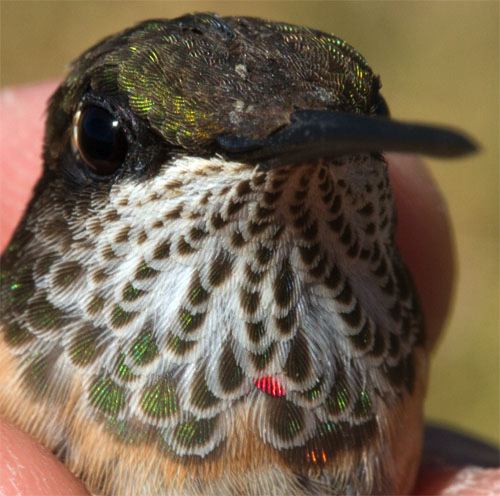
 a small mountain town about 90 minutes east of the San Jose airport. We had our usual happy reunion with Linda and Ernie Carman, Ernesto’s parents and proprietors of Finca Cristina, a 30-acre, fully organic, shade-grown coffee farm that produces Café Cristina--some of the finest coffee grown anywhere. We also reunited with Ela Villanueva, our all-time favorite tica whom Ernesto married in December 2009 during a Costa Rican ceremony in which we were pleased to participate.
a small mountain town about 90 minutes east of the San Jose airport. We had our usual happy reunion with Linda and Ernie Carman, Ernesto’s parents and proprietors of Finca Cristina, a 30-acre, fully organic, shade-grown coffee farm that produces Café Cristina--some of the finest coffee grown anywhere. We also reunited with Ela Villanueva, our all-time favorite tica whom Ernesto married in December 2009 during a Costa Rican ceremony in which we were pleased to participate.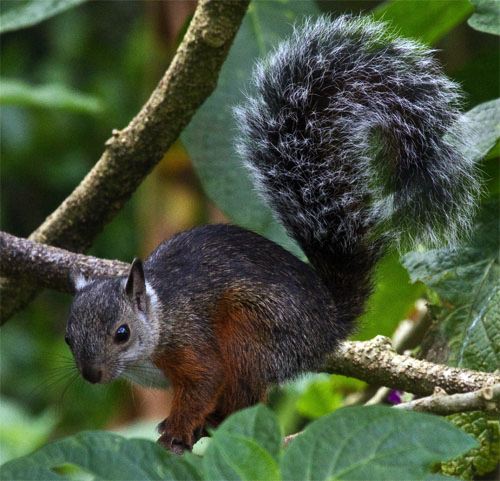
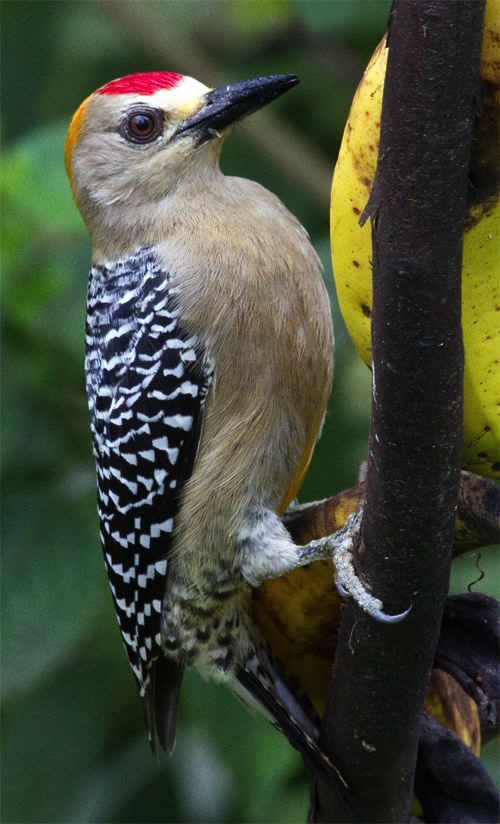
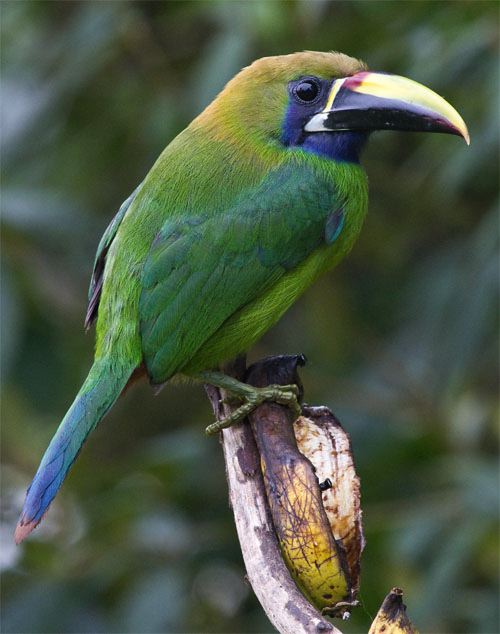
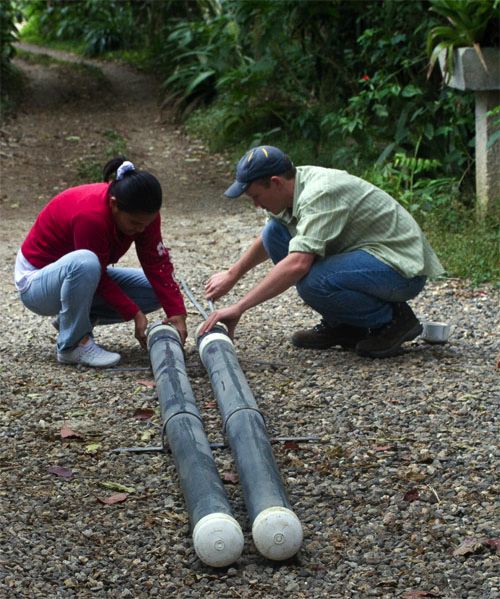
 as well as a separate quiver for transporting rebars we use to hold the net poles in place. Ernesto also cleaned up a portable banding table and stools that have proved quite useful in the field. After a couple of days of gracious hospitality from Linda and Ernie, on 28 January we (Ernesto and trip leader Bill Hilton Jr.) headed west through San Jose and onto a newly completed toll road that shortened by about an hour the old route over the Pan American Highway into Guanacaste (map above right).
as well as a separate quiver for transporting rebars we use to hold the net poles in place. Ernesto also cleaned up a portable banding table and stools that have proved quite useful in the field. After a couple of days of gracious hospitality from Linda and Ernie, on 28 January we (Ernesto and trip leader Bill Hilton Jr.) headed west through San Jose and onto a newly completed toll road that shortened by about an hour the old route over the Pan American Highway into Guanacaste (map above right). Accompanying Juan Diego--”JuanD” for short--was his girlfriend Mirna Salas (at left in photo), who’s also JuanD's classmate at University of Costa Rica’s Liberia campus. This group--Ernesto, JuanD, Mirna, trip leader Bill, and later on Ernesto’s wife, Ela--made up the 2011 “Omega Crew” that scouted the area and continued field work after this year’s trip participants from the U.S. had departed.
Accompanying Juan Diego--”JuanD” for short--was his girlfriend Mirna Salas (at left in photo), who’s also JuanD's classmate at University of Costa Rica’s Liberia campus. This group--Ernesto, JuanD, Mirna, trip leader Bill, and later on Ernesto’s wife, Ela--made up the 2011 “Omega Crew” that scouted the area and continued field work after this year’s trip participants from the U.S. had departed.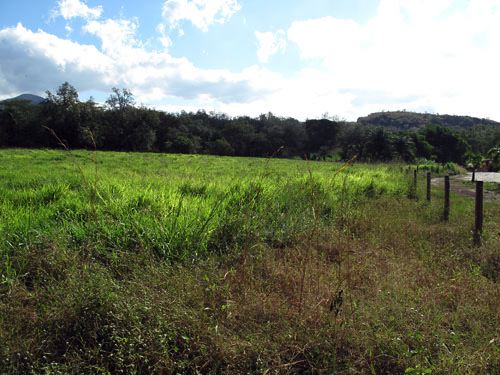

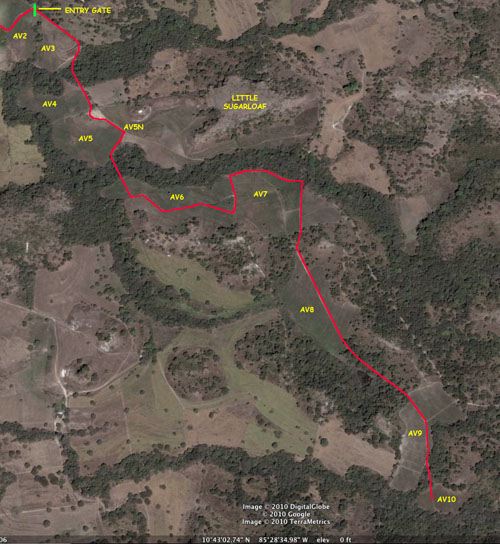
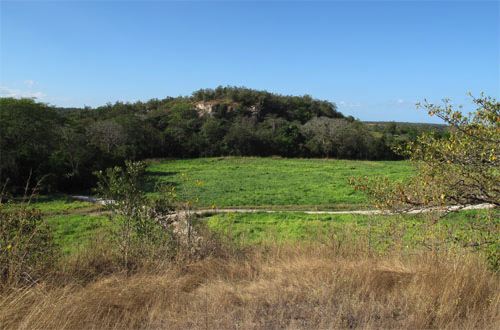
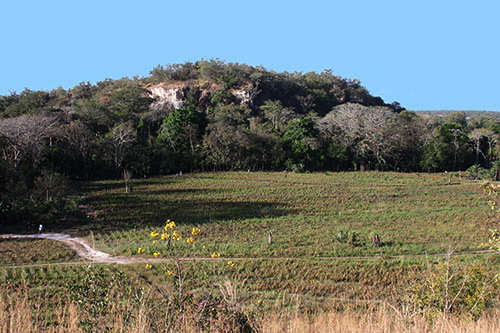
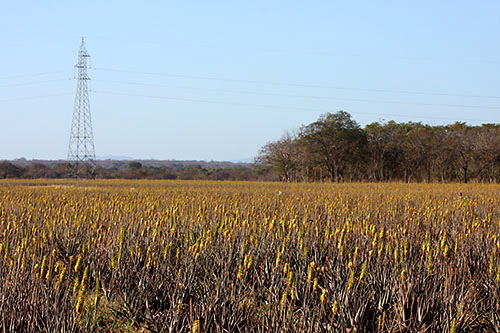
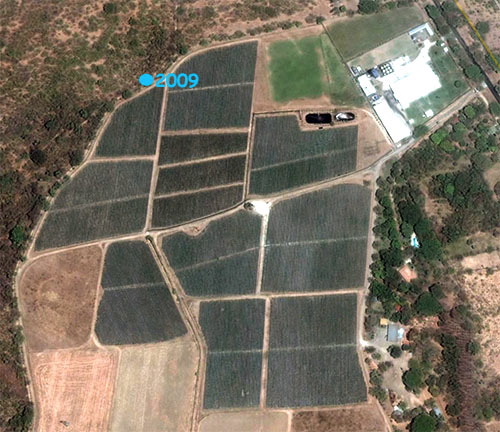

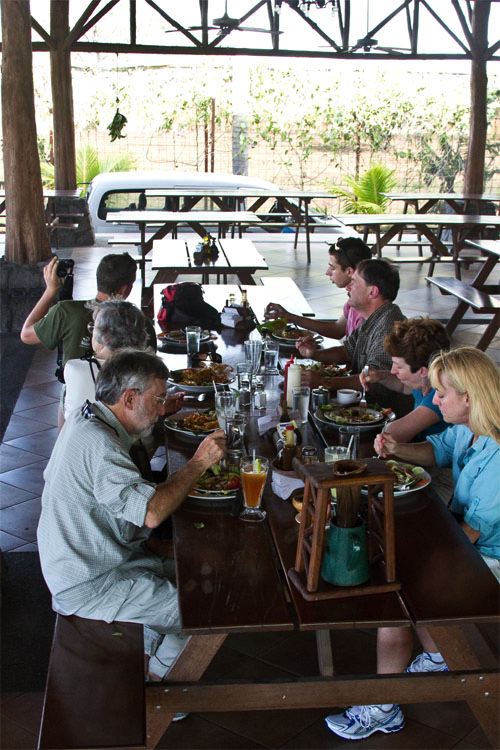
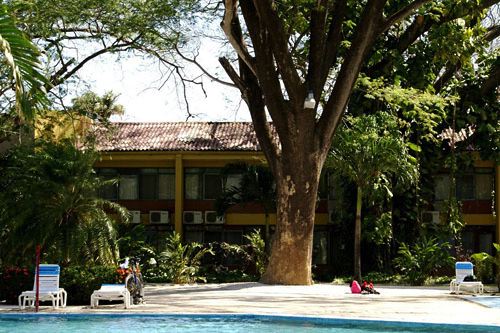
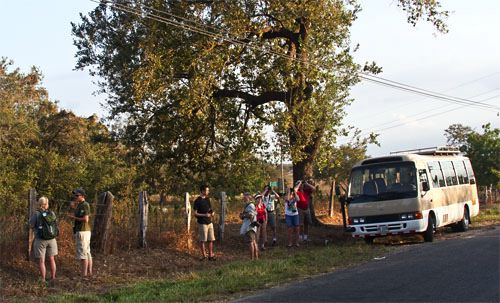
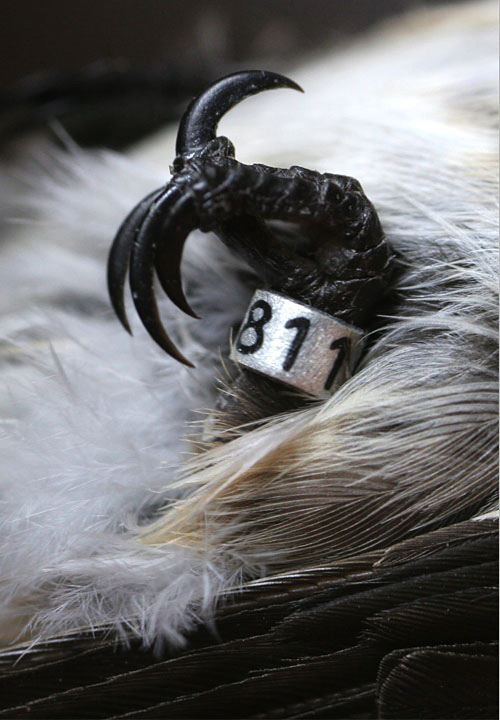

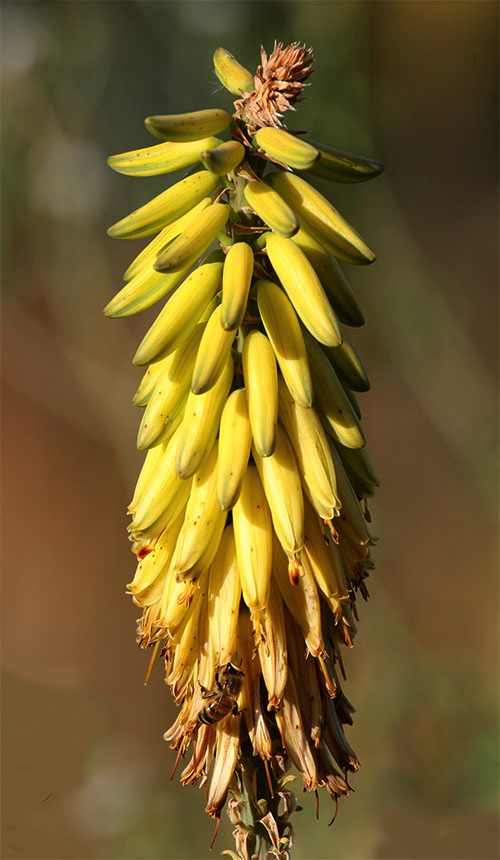
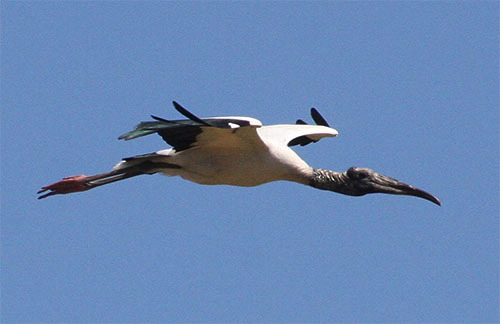

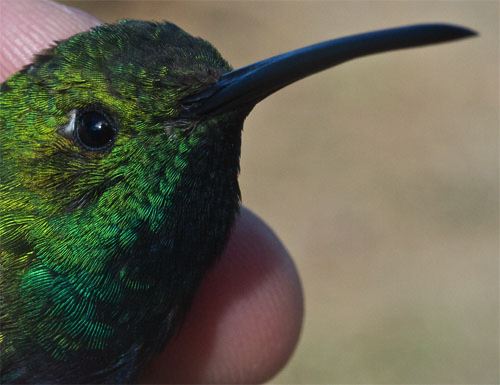
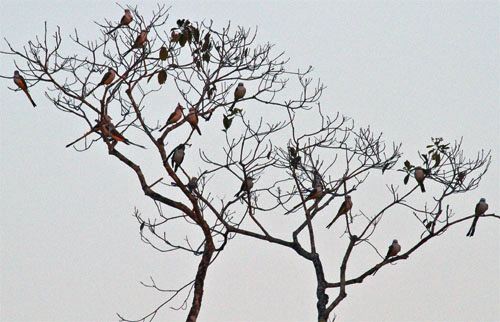

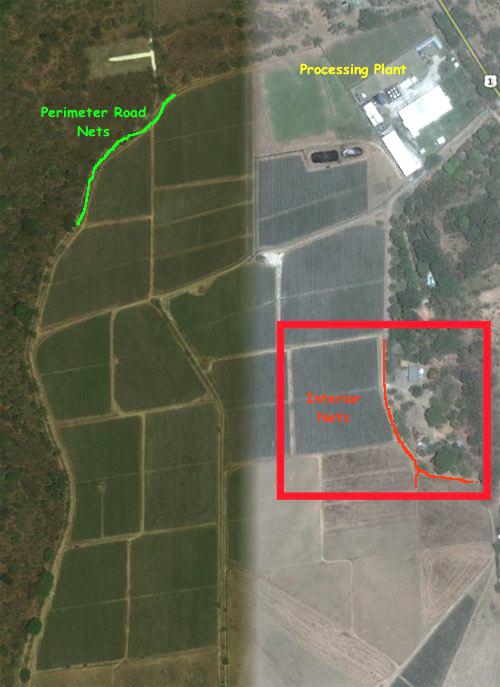
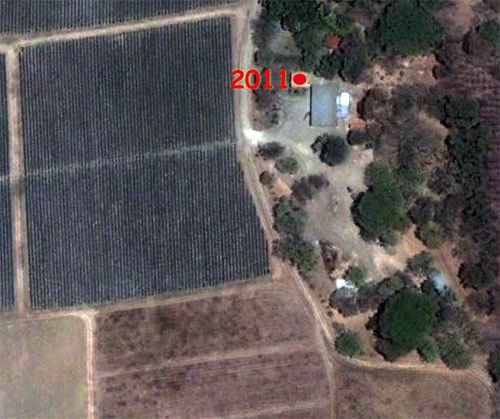
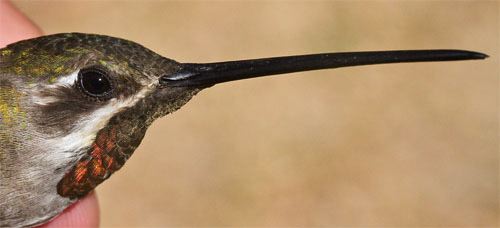
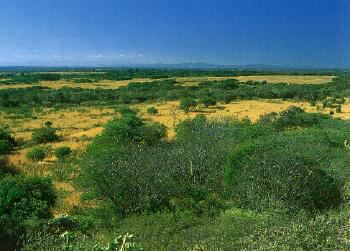 We shut the nets a little early on 1 February to prepare for a bus trip an hour north to Santa Rosa National Park (right), home of what is likely the largest remaining tropical dry forest in Central America. Although much of Guanacaste Province was logged and turned into farms or grazeland, Santa Rosa provides a snapshot of what the whole area must have looked like before Spanish settlers arrived. The park has pockets of both types of dry forest, with evergreen trees that hold their leaves year-round and deciduous ones that shed foliage as a way to prevent moisture loss during the dry season.
We shut the nets a little early on 1 February to prepare for a bus trip an hour north to Santa Rosa National Park (right), home of what is likely the largest remaining tropical dry forest in Central America. Although much of Guanacaste Province was logged and turned into farms or grazeland, Santa Rosa provides a snapshot of what the whole area must have looked like before Spanish settlers arrived. The park has pockets of both types of dry forest, with evergreen trees that hold their leaves year-round and deciduous ones that shed foliage as a way to prevent moisture loss during the dry season.